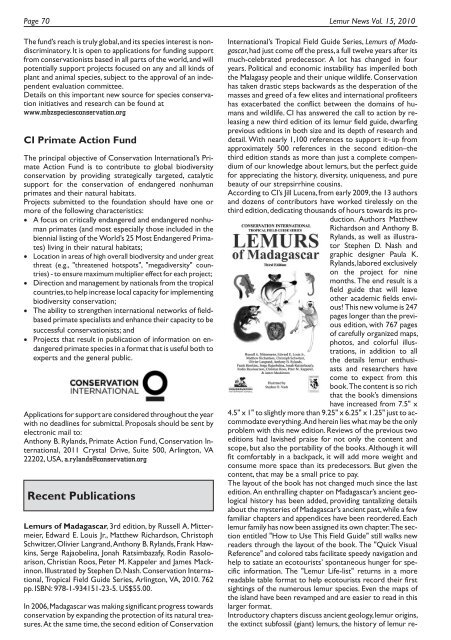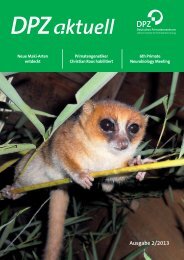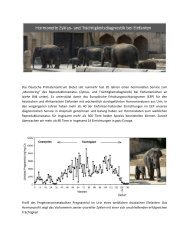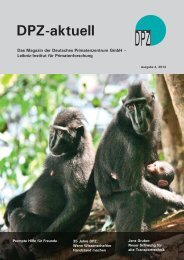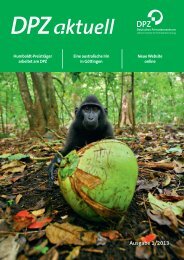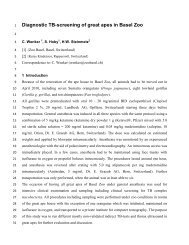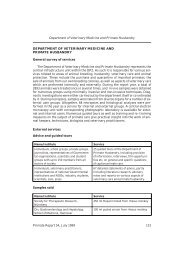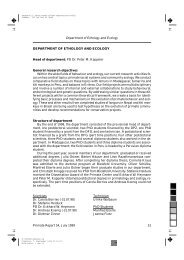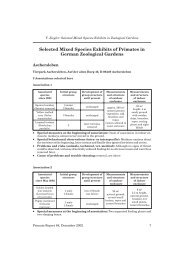Vol. 15 - Deutsches Primatenzentrum
Vol. 15 - Deutsches Primatenzentrum
Vol. 15 - Deutsches Primatenzentrum
You also want an ePaper? Increase the reach of your titles
YUMPU automatically turns print PDFs into web optimized ePapers that Google loves.
Page 70 Lemur News <strong>Vol</strong>. <strong>15</strong>, 2010<br />
The fund’s reach is truly global,and its species interest is nondiscriminatory.<br />
It is open to applications for funding support<br />
from conservationists based in all parts of the world,and will<br />
potentially support projects focused on any and all kinds of<br />
plant and animal species, subject to the approval of an independent<br />
evaluation committee.<br />
Details on this important new source for species conservation<br />
initiatives and research can be found at<br />
www.mbzspeciesconservation.org<br />
CI Primate Action Fund<br />
The principal objective of Conservation International’s Primate<br />
Action Fund is to contribute to global biodiversity<br />
conservation by providing strategically targeted, catalytic<br />
support for the conservation of endangered nonhuman<br />
primates and their natural habitats.<br />
Projects submitted to the foundation should have one or<br />
more of the following characteristics:<br />
A focus on critically endangered and endangered nonhuman<br />
primates (and most especially those included in the<br />
biennial listing of the World’s 25 Most Endangered Primates)<br />
living in their natural habitats;<br />
Location in areas of high overall biodiversity and under great<br />
threat (e.g., "threatened hotspots", "megadiversity" countries)<br />
- to ensure maximum multiplier effect for each project;<br />
Direction and management by nationals from the tropical<br />
countries,to help increase local capacity for implementing<br />
biodiversity conservation;<br />
The ability to strengthen international networks of fieldbased<br />
primate specialists and enhance their capacity to be<br />
successful conservationists; and<br />
Projects that result in publication of information on endangered<br />
primate species in a format that is useful both to<br />
experts and the general public.<br />
Applications for support are considered throughout the year<br />
with no deadlines for submittal. Proposals should be sent by<br />
electronic mail to:<br />
Anthony B. Rylands, Primate Action Fund, Conservation International,<br />
2011 Crystal Drive, Suite 500, Arlington, VA<br />
22202, USA, a.rylands@conservation.org<br />
Recent Publications<br />
Lemurs of Madagascar, 3rd edition, by Russell A. Mittermeier,<br />
Edward E. Louis Jr., Matthew Richardson, Christoph<br />
Schwitzer,Olivier Langrand,Anthony B.Rylands,Frank Hawkins,<br />
Serge Rajaobelina, Jonah Ratsimbazafy, Rodin Rasoloarison,<br />
Christian Roos, Peter M. Kappeler and James Mackinnon.Illustrated<br />
by Stephen D.Nash.Conservation International,<br />
Tropical Field Guide Series, Arlington, VA, 2010. 762<br />
pp. ISBN: 978-1-934<strong>15</strong>1-23-5. US$55.00.<br />
In 2006,Madagascar was making significant progress towards<br />
conservation by expanding the protection of its natural treasures.At<br />
the same time,the second edition of Conservation<br />
International’s Tropical Field Guide Series, Lemurs of Madagascar,had<br />
just come off the press,a full twelve years after its<br />
much-celebrated predecessor. A lot has changed in four<br />
years. Political and economic instability has imperiled both<br />
the Malagasy people and their unique wildlife. Conservation<br />
has taken drastic steps backwards as the desperation of the<br />
masses and greed of a few elites and international profiteers<br />
has exacerbated the conflict between the domains of humans<br />
and wildlife. CI has answered the call to action by releasing<br />
a new third edition of its lemur field guide, dwarfing<br />
previous editions in both size and its depth of research and<br />
detail. With nearly 1,100 references to support it–up from<br />
approximately 500 references in the second edition–the<br />
third edition stands as more than just a complete compendium<br />
of our knowledge about lemurs, but the perfect guide<br />
for appreciating the history, diversity, uniqueness, and pure<br />
beauty of our strepsirrhine cousins.<br />
According to CI’s Jill Lucena,from early 2009,the 13 authors<br />
and dozens of contributors have worked tirelessly on the<br />
third edition,dedicating thousands of hours towards its production.<br />
Authors Matthew<br />
Richardson and Anthony B.<br />
Rylands, as well as illustrator<br />
Stephen D. Nash and<br />
graphic designer Paula K.<br />
Rylands,labored exclusively<br />
on the project for nine<br />
months. The end result is a<br />
field guide that will leave<br />
other academic fields envious!<br />
This new volume is 247<br />
pages longer than the previous<br />
edition, with 767 pages<br />
of carefully organized maps,<br />
photos, and colorful illustrations,<br />
in addition to all<br />
the details lemur enthusiasts<br />
and researchers have<br />
come to expect from this<br />
book.The content is so rich<br />
that the book’s dimensions<br />
have increased from 7.5" x<br />
4.5" x 1" to slightly more than 9.25" x 6.25" x 1.25" just to accommodate<br />
everything.And herein lies what may be the only<br />
problem with this new edition. Reviews of the previous two<br />
editions had lavished praise for not only the content and<br />
scope, but also the portability of the books. Although it will<br />
fit comfortably in a backpack, it will add more weight and<br />
consume more space than its predecessors. But given the<br />
content, that may be a small price to pay.<br />
The layout of the book has not changed much since the last<br />
edition. An enthralling chapter on Madagascar’s ancient geological<br />
history has been added, providing tantalizing details<br />
about the mysteries of Madagascar’s ancient past,while a few<br />
familiar chapters and appendices have been reordered. Each<br />
lemur family has now been assigned its own chapter.The section<br />
entitled "How to Use This Field Guide" still walks new<br />
readers through the layout of the book. The "Quick Visual<br />
Reference" and colored tabs facilitate speedy navigation and<br />
help to satiate an ecotourists’ spontaneous hunger for specific<br />
information. The "Lemur Life-list" returns in a more<br />
readable table format to help ecotourists record their first<br />
sightings of the numerous lemur species. Even the maps of<br />
the island have been revamped and are easier to read in this<br />
larger format.<br />
Introductory chapters discuss ancient geology,lemur origins,<br />
the extinct subfossil (giant) lemurs, the history of lemur re-


